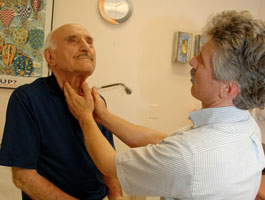Evidence-based guidelines, best practices and health promotion

Evidence-based guidelines
The CareOregon Quality Management Committee (QMC) approves guidelines that are evidence-based and reviewed at least biennially by a nationally recognized body of experts on the topic. Once approved, these are placed on the website. Paper copies are also available upon request.
For more information on the guideline selection and approval process, see Clinical Guidelines Policy.
Health Share of Oregon is also publishing Clinical Guidelines, available on their website.
CareOregon-approved guidelines | |||
Topic | Additional resources | Source | Approved by CareOregon QMC |
| Tobacco cessation | See below | 2008 AHRQ | December 2023 |
| Childhood immunizations | See below | 2025 CDC | January 14, 2025 |
| Adult immunizations | See below | 2018 CDC | December 22, 2022 |
| Congestive heart failure (CHF) | See below | 2016 ACC/AHA/HFS | August 2023 |
| Diabetes (diagnosis and management of Type 2 diabetes in adults) | See below | 2025 ADA | September 2025 |
| Early childhood cavity prevention | See below | 2014 AAP | February 14, 2023 |
| Oral health care during pregnancy and through the lifespan | See below | ACOG | March 2025 |
| Attention Deficit Hyperactivity Disorder (ADHD) - AAFP | See below | 2016 AAFP | June 2023 |
| Attention Deficit Hyperactivity Disorder (ADHD) - CDC | See below | 2017 CDC | June 2023 |
| Asthma | See below | 2018 CDC/NHLBI | August 2025 |
| Adult preventive services | See below | 2017 USPSTF | October 2023 |
| Child/adolescent preventive services | See below | 2017 USPSTF | October 2023 |
| Substance abuse screening | See below | 2016 SAMHSA | December 2023 |
| Depression (ACP) | See below | 2015 ACP | November 2025 |
| Depression (VA/DoD) | See below | 2022 VA/DoD | November 2025 |
| Depression (USPSTF) | See below | 2023 USPSTF | November 2025 |
| Palliative care | 2021 JNCCN | May 2025 | |
The Centers for Disease Control and Prevention (CDC) says that more deaths are caused each year by tobacco use than from human immunodeficiency virus (HIV), illegal drug use, alcohol use, motor vehicle injuries, suicides and murders combined. Research confirms that secondhand smoke causes disease and premature death in children and adults who do not smoke.
Tobacco use and dependence: CareOregon-approved guidelines
Tobacco Use Screening and Brief Intervention
Additional tobacco cessation resources
- Treating Tobacco Use and Dependence
- Quick Reference Guide for Clinicians: Treating Tobacco Use and Dependence
- Oregon Statewide Tobacco Control Plan 2005-2010: Taking Action for a Tobacco-Free Oregon
- Treating Tobacco Use and Dependence
- Smoking and Tobacco Use
Brief clinical strategies for patients willing to quit (five A's)
- Ask about tobacco use. Identify and document tobacco use status for every patient at every visit.
- Advise to quit. In a clear, strong and personalized manner, urge every tobacco user to quit.
- Assess willingness to try to quit. Is the tobacco user willing to quit now?
- Assist in quit attempt. For patients willing to make a quit attempt, use counseling and pharmacotherapy to help them quit.
- Arrange follow-up. Schedule follow-up contact, preferably within the first week after the quit date.
Helping patients stay motivated to quit
- Relevance. Encourage the patient to indicate why quitting is personally relevant, being as specific as possible. Motivational information has the greatest impact if it is relevant to a patient’s health status or risk.
- Risks. Ask the patient to identify potential negative consequences of tobacco use.
- Acute risks (e.g., shortness of breath, harm to pregnancy)
- Long-term risks (e.g., heart attacks and strokes, cancers)
- Environmental risks (e.g., increased risk of heart, lung and cancer disease among family members)
- Rewards. Ask the patient to identify potential benefits of stopping tobacco use. Highlight benefits that are most relevant to the patient, such as:
- Saving money
- Improving health
- Food will taste better
- Setting a good example for children
- Having healthier babies and children
- Roadblocks. Ask patients to identify their barriers and concerns about quitting. Common barriers and concerns may include:
- Weight gain
- Withdrawal symptoms
- Lack of support
- Enjoyment of tobacco
- Repetition. Repeat the motivational intervention every time an unmotivated patient visits the clinic. Remind patients that successful quitting often requires several attempts.
Supporting patients who have recently quit: Preventing relapse
The following interventions should be part of every visit with a patient who has recently quit:
- Congratulate patients on any success and strongly encourage them to remain abstinent.
- Use open-ended questions to encourage patients to problem-solve challenges.
Encourage the patient to talk about problems or anticipated threats to remaining abstinent.
CareOregon benefits
Pharmacotherapy
Pharmacotherapy is fully covered by CareOregon. CareOregon requires a physician’s prescription for all pharmacotherapy options. Nicotine replacement therapy (NRT) includes gum, patch, lozenges and inhalers. Bupropion SR (Zyban) and Chantix are covered. Chantix requires a written prescription and the member is encouraged to be enrolled in the Quit For Life® Tobacco Cessation Program.
Approved therapies are in the CareOregon Formulary on our website. Ask Oregon Tobacco Quit Line staff about dosages and contraindications for these pharmaceuticals. The toll-free number is 800-QUIT-NOW (800-784-8669).
Pharmacotherapy during pregnancy
CareOregon supports the clinical practice guideline developed by the U.S. Department of Health and Human Services Public Health Service (Treating Tobacco Use and Dependence, June 2008) about using nicotine replacement therapy and Bupropion during pregnancy. Search for “Bupropion” in the formulary.
Use the five A’s — brief interventions — with a pregnant patient. Urge the patient to enroll in an intensive behavioral counseling service, such as the Quit For Life® Program.
Consider pharmacotherapy if a patient is a heavy tobacco user and is unable to quit with counseling only, and the potential benefits and likelihood of quitting outweigh potential risks.
Strong evidence supports proactive telephone counseling, group counseling and individual counseling in tobacco cessation. Nicotine replacement therapy is most effective when used with structured behavioral counseling.
Counseling
Tobacco cessation services are covered by CareOregon for both OHP and CareOregon Medicare Advantage members. No referral is required to provide tobacco cessation treatment and counseling. Providers are encouraged to follow the five A’s model for treating tobacco use and dependence.
The free Oregon Tobacco Quit Line (800-QUIT-NOW) is the first referral for providers without an in-house program. Providers may ask about recommended dosing levels and contraindications for NRT. The Quit For Life® Program is a covered benefit limited to twice in a 12-month period. It offers telephone counseling and support.
If your patient wants to set a quit date, fax a referral form to the Quit Line. A counselor will contact the patient. Registered callers may call the Quit Line for free cessation counseling as needed.
To contact the Oregon Tobacco Quit Line:
Fax: 800-483-3114
Call: 800-QUIT-NOW (800-784-8669) or TTY 711
Website: Oregon Tobacco Quit Line
Spanish-speaking counselors: 877-2NO-FUME (877-266-3863)
Patient information
Order patient information from the CareOregon Communications Department, 503-416-1741, or email materials@careoregon.org. To order a free copy of CareOregon’s stop smoking packet to be mailed to your patient, call Customer Service at 800-224-4840. Please provide the member’s name and mailing address (one per household).
- Help for Smokers and Other Users
- You Can Quit Smoking 5-Day Countdown to Your Quit Date (English)
- You Can Quit Smoking 5-Day Countdown to Your Quit Date (Spanish)
- Good Information for Smokers
- Need Help Putting Out That Cigarette? (24-page booklet for pregnant women)
Resources
- Oregon Tobacco Quit Line. (Spanish-speaking counselors available)
- Quit For Life® Program (PDF): call toll-free 866-784-8454
- How Health Care Professionals Can Help Pregnant Smokers Quit (PDF)
- Smoke-Free Families
- Treating Tobacco Use and Dependence: Clinical Practice Guideline (U. S. Department of Health and Human Services)

CareOregon shares data with the Oregon ALERT Immunization Registry and encourages providers to use this database to obtain immunization records for patients they are seeing. This is the best source for immunizations given by multiple providers and at multiple locations. This registry helps ensure up-to-date information and accurate and timely immunizations.
For more information, please visit the website.
Immunizations: CareOregon-approved guidelines
Additional immunization resources
- CDC: Recommendations and Guidelines: Vaccine Storage and Handling
- Immunization Action Coalition: Immunization VIS, Administration and Safety Information
Tools
- MCHD: Management Guide to: Pediatric Immunizations (at 24 months) Toolkit
- DHS training videos are available here.
CareOregon-approved guidelines
Additional chronic heart failure resources
CareOregon-approved guidelines
- Standards of Medical Care in Diabetes
- 2023 ESC Guidelines for the management of cardiovascular disease in patients with diabetes
Additional resources for diabetes care
- Diabetes Medication Pearls
- The National Diabetes Education Program (NDEP) website offers best practices information as well as member educational materials
- Diabetes Treatment Pathway
CareOregon-approved guidelines
- Diagnosis, Evaluation, and Treatment of Attention-Deficit/Hyperactivity Disorder in Children and Adolescents
- Diagnosis and Evaluation of ADHD based on the AAP Guideline
Additional resources for ADHD care
CareOregon-approved guidelines
Additional resources for asthma care
- Guidelines for the Diagnosis and Management of Asthma
- Clinical Evidence Review: Best Practices Asthma: Permanente Journal
- Improving Asthma Care for Children Toolkit: Best Practices in Medicaid Managed Care
CareOregon-approved guidelines
- Preventive Services for Adults
- Preventive Services for Children and Adolescents (Please note: Because our Medicaid population includes many children, CareOregon covers blood lead screenings as a Level I preventive service, not a Level III preventive service as listed in this document)
Additional preventive services resources
CareOregon-approved guidelines
Additional resources for substance use disorders

